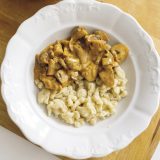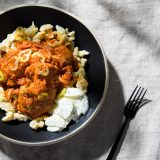His lumbering pit bull “Princess” at his heels, András Mészáros pulled three tiny red packets from his kitchen cabinet, waving each at me in turn, opening them so I could get a whiff. “This is friendly. This is angry. This is deadly. You choose.”
As such stories must, this one began at a bar in Budapest just 24 hours earlier, where the only free seat was at a table with Mészáros, one of Hungary’s leading action movie stars. Because of course. He insisted on sharing shots of Unicum, his country’s national and potent herbal liqueur that tastes a bit of Jägermeister spiked with Vicks VapoRub.
Sometime between the second and fifth shots, he mentioned his kitchen prowess, particularly pertaining to Hungary’s other core culinary achievement—chicken paprikash, or paprikás csirke, as the saucy blend of chicken, onions, sour cream and paprika is called there. “I don’t know many tricks, just how my father did it.”
As he described his recipe, I realized how little I knew about a dish that once was de rigueur family dinner fare in 1960s America. Which is how I soon found myself in his kitchen, more shots of Unicum, Princess begging for scraps. As for friendly, angry or deadly? Dealer’s choice, I told him of the varying intensities of paprika he’d offered. He laughed. “A little of each, then!”
Perhaps “little” got lost in translation. As he cooked down a heap of chopped onions, Mészáros added paprika not by the pinch or spoonful, but by heaping quarter cups at a time. It looked inedible. Maybe an action star isn’t the best culinary guide?
Until I tasted it. Wildly savory, tender chunks of chicken thighs bathed in a sauce at once rich, tangy, creamy, sweet, smoky and just a bit spicy. And tons of body. Heaped over a mound of irregularly shaped chewy-yet-light dumplings Mészáros had made from scratch, it was the sort of comfort food that drew you back bite after bite.
More than delicious, it also taught a valuable lesson. Chicken paprikash isn’t a chicken dish flavored with paprika and onions. It’s a paprika and onion dish in which there is chicken.
The Paprika
To understand chicken paprikash—in fact, to understand Hungarian food at all—you must start with the paprika, a term in Hungarian that unhelpfully can mean almost anything related to peppers. Fresh peppers. Dried peppers. The ground dry spice made from the peppers. Pepper sauces, pastes and purees. All of it “paprika.” When I asked Mészáros how he knows which is meant, he shrugged. “You feel it.”
Paprika is the backbone of Hungarian cuisine. The dry spice we know best is used voluminously in everything from cocktails and breads to classic soups and stews, such as goulash. Children even sprinkle it on rice pudding and cakes. Made by drying and grinding peppers, paprika can be sweet, mild or spicy, with textures ranging from fine to moderate to coarse.
And as I’d seen, in many cases, paprika isn’t just a seasoning. It’s the reason for the dish. “You think you use it as a spice, but actually you use it as the base” of almost everything, explained Zsófia Mautner, a former Hungarian diplomat turned cookbook author. “The holy trinity of Hungarian cooking is always the same—fat, onion and paprika.”
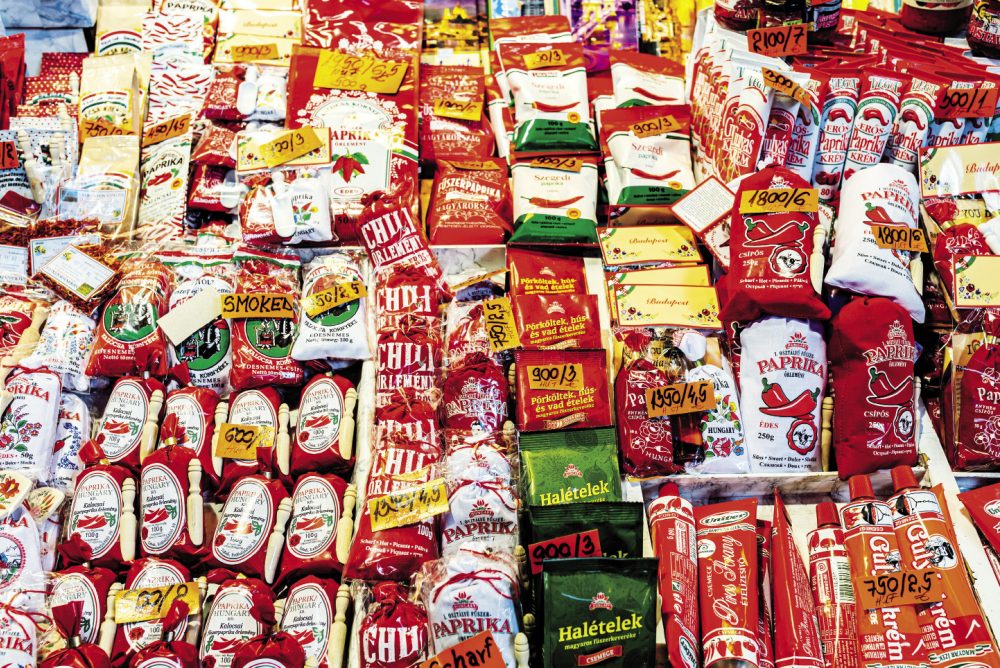
In markets across Hungary, vendors offer dozens of varieties of paprika, which cooks often combine to create dishes with layers of peppery flavor.
But it wasn’t always so ubiquitous. Paprika was introduced to Hungary—first as a decorative flourish, then as medicine, only later for flavor—by the Turks some 400 years ago. Before that, local seasonings focused mostly on saffron and ginger.
During the four decades of socialist rule that ended late last century, it was illegal to produce your own paprika, a period when it wasn’t uncommon to pay off the police with black market spice. Today, Hungarians prize freshly made paprika so highly that many maintain backyard patches, particularly in the south, where the climate fosters field upon field of pepper plants and roadside stands offering stringed clusters of dried peppers for do-it-yourself paprika.
Though some family farms still produce paprika using traditional methods—growing the peppers organically, drying them slowly over wood fires, grinding them over and again to get just the right texture—most paprika now is commercially produced. And much of that is cut with paprika imported from China, which still can be labeled Hungarian, much to the dismay of locals.
The History
Though paprika has dominated Hungarian cooking for centuries and chicken paprikash itself remains one of the country’s most notable culinary exports, the dish actually is a relative newcomer to the cuisine. In a way, credit goes to the French. Or rather, to an obsession with French cooking.
The origins of chicken paprikash predate the introduction of paprika and can be traced back to a simple one-pot chicken stew, a dish favored by the poor and thus often bolstered by large quantities of inexpensive onions. In time, paprika was added—and later a spare amount of tomato—creating a dish known as pörkölt.
Pörkölt remains a distinct dish eaten today. Stewy and richly sweet with paprika, it can be made with beef, pork, chicken, even mushrooms. It wasn’t until about 100 years ago that chicken paprikash diverged to become its own thing. Which is how I found myself dining outdoors surrounded by adults wearing the sorts of animal costumes fit for a Chuck E. Cheese.
Tucked along the edge of Napozórét park in Budapest, Gundel Étterem is a sprawling restaurant that dates to the 1890s and in its heyday would seat 1,000 or more at a time. Its dining rooms spill al fresco and large bronze statues of apes and other zoo creatures peer at you from behind trees. And yes, costumed characters are on hand to entertain you.
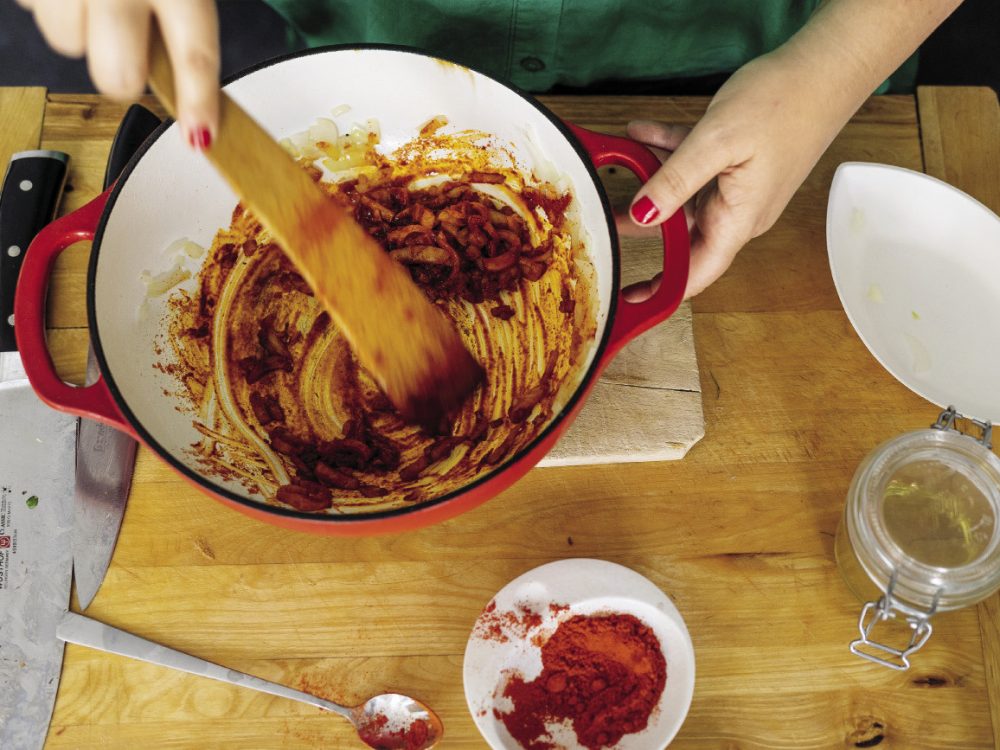
“The holy trinity of Hungarian cooking is always
the same,” says cookbook author Zsófia Mautner.
“Fat, onion and paprika.”
It’s an odd juxtaposition for a restaurant considered one of the finest of its time, an era when the social set would gather there to talk politics and taste the latest in Continental cuisine. French fare was considered the height of modern cooking, and Hungarian chefs were eager to adopt its tastes and techniques.
As the story goes, around 1920, a Gundel chef seeking to mimic the French use of heavy cream to create luxurious sauces doctored a chicken pörkölt with the more common option in Hungary—sour cream. The resulting thickened, tangy and boldly red sauce became the hallmark of what is now chicken paprikash.
“The sauce is the spirit of this dish. If you don’t have enough sauce, the dish is ruined,” said Gundel’s owner, Zoltán Kőrössy. Indeed, the restaurant’s sauce has evolved into a 24-hour process in which chicken broth, duck fat, onions, garlic, paprika—of course—and sour cream are cooked with constant stirring to create a wonderful blend with which to bathe chicken.
Served with those same tender dumplings, called nokedli, and a tangy-bright cucumber salad dressed with yet more sour cream—perfect for cutting through the richness of the paprikash—it was sensational. It also was a tremendous amount of work. Anything stirred and cooked for a day is an unlikely recipe for making the jump to the home cook.
The Home Cook
As ever, for a home cook-friendly solution, seek out a talented home cook. Which is how I met Erika Hobotnè, who began my cooking lesson at her home on the outskirts of Budapest with a shot of plum pálinka, a Hungarian brandy almost as common as paprika. Nobody had warned me that learning to prepare chicken paprikash involved downing quite so many shots of hard liquor.
“This is the true Hungarian paprika,” she said, holding a container of brilliantly colored local spice. “It’s very red, and that is what it should look like. Sweet paprika is bright red. Hot paprika resembles cinnamon. We’ll use both.”
That was another important lesson. By this point in my trip, I’d tasted dozens of iterations of chicken paprikash—not to mention a handful of mushroom and pork paprikash. And invariably the best versions always drew their flavor from multiple sources of paprika. Sweet. Hot. Fresh. Even—as Hobotnè would teach me—pureed.
She began by browning a generous mound of chopped onions. Some cooks aim for well browned, but she prefers the sweetness of a gentler caramelization. Then a full ¼ cup sweet paprika, a few ample spoonfuls of hot paprika, a chopped tomato and a sliced large banana pepper. As it simmered, she added boneless, skinless chicken thighs.
While the chicken cooked, Hobotnè prepared the nokedli, a simple and delicious accompaniment. In the U.S., the dish often is as much about the wispy egg noodles it is served over as it is the chicken. In Hungary, the paprikash is the star, with robust tender-chewy Spätzle-like dumplings a sideshow that nonetheless holds its own against the main attraction.
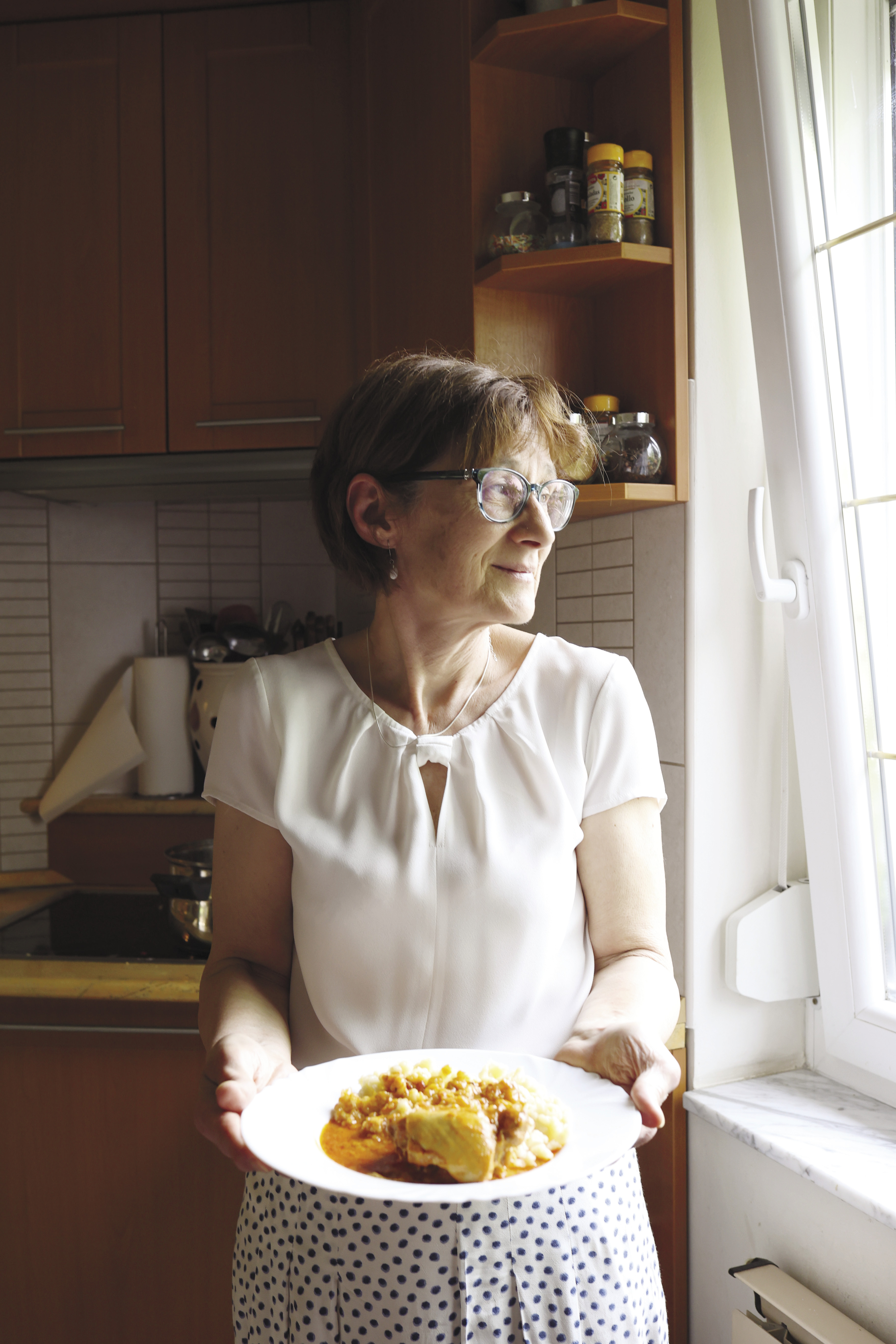
Made from nothing more than flour, eggs, salt and water, the pancake-like batter was spooned onto what resembled a large-holed cheese grater held above a pot of boiling water. Using a flat spatula, Hobotnè smooshed the batter through the holes, letting nodules of it drop into the water. Within minutes, the plump dumplings floated to the top.
When the chicken was done, Hobotnè reached for yet another form of paprika, this time a thick tomato paste-like puree. Made from pureed fresh and roasted peppers, chili flakes and vinegar, it had a bright, tangy flavor layered over earthy richness and spice. She stirred in bold spoonfuls of it, nearly matching the volume of dried paprika.
The final stroke? Ladling out a bit of the liquid—of which there actually was very little thanks to simmering uncovered—and stirred about a cup of sour cream into it before returning the mixture to the pot. Dumplings and paprikash married on the plate, a neat pile of cucumber salad on the side. The result? Unbelievably delicious.
The onions had almost melted into the sauce, adding sweetness that both balanced and complemented the richness of the various paprikas. The sour cream gave everything a rounded creaminess that itself was balanced by the spice of the hot paprika. The chicken was moist and fork-tender. The nokedli were the perfect sponge, the cucumbers the perfect foil.
Most importantly, there was a brightness that had been lacking in so many other versions I’d had, a brightness added by the paprika puree. Once again proving that more paprika—and more paprika varieties—is the secret to great paprikash.

